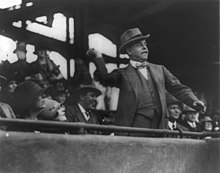Nicholas Longworth

Nicholas Longworth (* 5. November 1869 in Cincinnati , Ohio ; † 9. April 1931 in Aiken , South Carolina ) was an American politician of the Republican Party , a member of the US House of Representatives for Ohio and Speaker of the House .
biography
Family relationships and professional career
Longworth was a great-nephew of Bellamy Storer, Sr. , an Ohio congressman and professor at the Law School of Cincinnati University, and the nephew of Bellamy Storer, Jr. , who also represented Ohio in the House of Representatives and was US Ambassador to Belgium , Spain and Austria was.
After attending the Franklin School in Cincinnati, Longworth studied at Harvard University , where he obtained a Bachelor of Arts (BA) in 1891 . A subsequent postgraduate study of law at the Law School of Harvard University and from 1892 at the University of Cincinnati , he graduated in 1894 and, after his admission, took up a position as a lawyer in Cincinnati in the same year . In 1898 he became a member of the school board (Board of Education) Cincinnatis.
Longworth began his political career as a member of the Ohio House of Representatives , to which he was elected in 1899 and 1900. He then sat in the Ohio Senate between 1901 and 1903 . In 1902 he was elected to the US House of Representatives for the first time , and after four re-elections from March 4, 1903 to March 3, 1913, he represented Ohio's first congressional electoral district.
Son-in-law of Theodore Roosevelt and Speaker of the House of Representatives

On February 17, 1906, he married the eldest daughter of US President Theodore Roosevelt , Alice Lee Roosevelt .
This familial situation led to a politically conditioned family dispute between the couple in 1912. After Roosevelt lost his nomination for the Republican candidate for the 1912 US presidential election to William Howard Taft , withdrew his delegates from the nomination convention and founded the Progressive Party , many of Roosevelt's closest political allies, including Nicholas Longworth, came to support Roosevelt. Roosevelt's daughter Alice, on the other hand, stood by her father, which created an ongoing conflict in their marriage. For men like Longworth, who wanted a political future, it seemed too radical a move to break away from the Republican Party's top candidate. Many progressively minded Republicans, who did not aspire to electoral office, showed solidarity with the Democrat Woodrow Wilson . Wilson clearly won the presidential election with 41.8 percent of the vote and 435 electors, while Roosevelt received 27.4 percent and 88 electors as second and Taft as third received 23.2 percent of the vote, but only eight electors.
Longworth himself also suffered a defeat in the 1912 US Congress against his Democratic challenger Stanley E. Bowdle . In the 1914 congressional elections, however, he managed to defeat Bowdle and become a member of the House of Representatives again. There he represented after eight subsequent re-elections from March 4, 1915 until his death again the first congressional electoral district of Ohio. Between 1923 and 1925 he was group leader of the Republicans and thus leader of the majority group (Majority Leader) .
On December 7, 1925, he was finally elected Speaker of the House of Representatives and held this position nominally until the end of the legislative period of the 71st Congress on March 3, 1931.
After his death he was buried in Spring Grove Cemetery in Cincinnati.
literature
- Clara Longworth de Chambrun: The Making of Nicholas Longworth. Annals of an American Family. Ray Long and Richard R. Smith, Inc., New York NY 1933 (Reprinted. Books for Libraries Press, New York NY 1971, ISBN 0-8369-5882-9 ).
Web links
- Nicholas Longworth in the Biographical Directory of the United States Congress (English)
- Nicholas Longworth in the nndb (English)
| personal data | |
|---|---|
| SURNAME | Longworth, Nicholas |
| BRIEF DESCRIPTION | American (Republican Party) politician, Speaker of the House of Representatives |
| DATE OF BIRTH | November 5, 1869 |
| PLACE OF BIRTH | Cincinnati , Ohio |
| DATE OF DEATH | April 9, 1931 |
| Place of death | Aiken , South Carolina |


